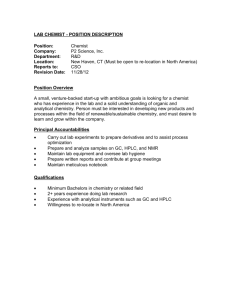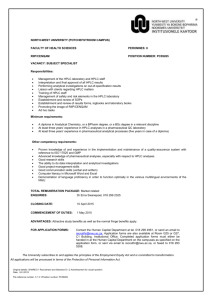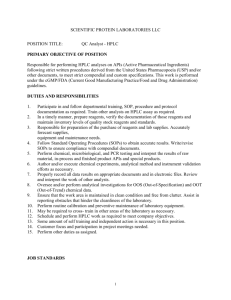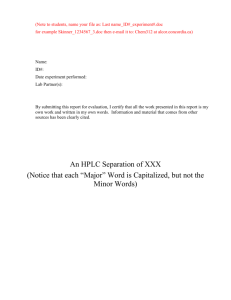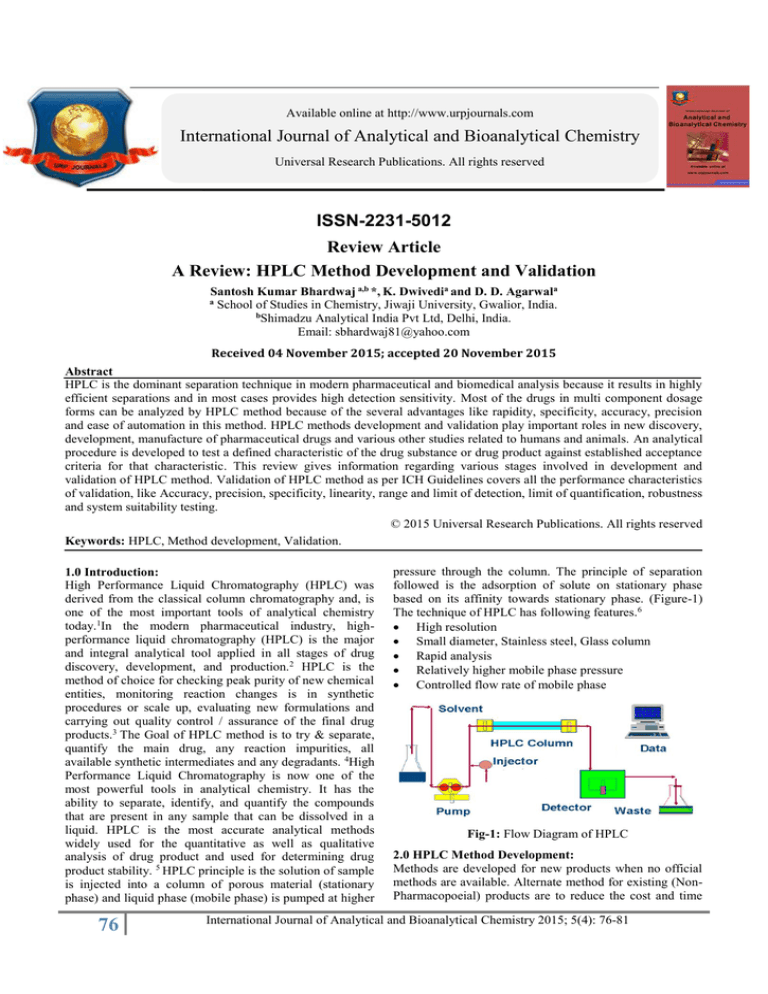
Available online at http://www.urpjournals.com
International Journal of Analytical and Bioanalytical Chemistry
Universal Research Publications. All rights reserved
ISSN-2231-5012
Review Article
A Review: HPLC Method Development and Validation
Santosh Kumar Bhardwaj a,b *, K. Dwivedia and D. D. Agarwala
School of Studies in Chemistry, Jiwaji University, Gwalior, India.
b
Shimadzu Analytical India Pvt Ltd, Delhi, India.
Email: sbhardwaj81@yahoo.com
a
Received 04 November 2015; accepted 20 November 2015
Abstract
HPLC is the dominant separation technique in modern pharmaceutical and biomedical analysis because it results in highly
efficient separations and in most cases provides high detection sensitivity. Most of the drugs in multi component dosage
forms can be analyzed by HPLC method because of the several advantages like rapidity, specificity, accuracy, precision
and ease of automation in this method. HPLC methods development and validation play important roles in new discovery,
development, manufacture of pharmaceutical drugs and various other studies related to humans and animals. An analytical
procedure is developed to test a defined characteristic of the drug substance or drug product against established acceptance
criteria for that characteristic. This review gives information regarding various stages involved in development and
validation of HPLC method. Validation of HPLC method as per ICH Guidelines covers all the performance characteristics
of validation, like Accuracy, precision, specificity, linearity, range and limit of detection, limit of quantification, robustness
and system suitability testing.
© 2015 Universal Research Publications. All rights reserved
Keywords: HPLC, Method development, Validation.
1.0 Introduction:
High Performance Liquid Chromatography (HPLC) was
derived from the classical column chromatography and, is
one of the most important tools of analytical chemistry
today.1In the modern pharmaceutical industry, highperformance liquid chromatography (HPLC) is the major
and integral analytical tool applied in all stages of drug
discovery, development, and production.2 HPLC is the
method of choice for checking peak purity of new chemical
entities, monitoring reaction changes is in synthetic
procedures or scale up, evaluating new formulations and
carrying out quality control / assurance of the final drug
products.3 The Goal of HPLC method is to try & separate,
quantify the main drug, any reaction impurities, all
available synthetic intermediates and any degradants. 4High
Performance Liquid Chromatography is now one of the
most powerful tools in analytical chemistry. It has the
ability to separate, identify, and quantify the compounds
that are present in any sample that can be dissolved in a
liquid. HPLC is the most accurate analytical methods
widely used for the quantitative as well as qualitative
analysis of drug product and used for determining drug
product stability. 5 HPLC principle is the solution of sample
is injected into a column of porous material (stationary
phase) and liquid phase (mobile phase) is pumped at higher
76
pressure through the column. The principle of separation
followed is the adsorption of solute on stationary phase
based on its affinity towards stationary phase. (Figure-1)
The technique of HPLC has following features.6
High resolution
Small diameter, Stainless steel, Glass column
Rapid analysis
Relatively higher mobile phase pressure
Controlled flow rate of mobile phase
Fig-1: Flow Diagram of HPLC
2.0 HPLC Method Development:
Methods are developed for new products when no official
methods are available. Alternate method for existing (NonPharmacopoeial) products are to reduce the cost and time
International Journal of Analytical and Bioanalytical Chemistry 2015; 5(4): 76-81
for better precision and ruggedness. When alternate method
proposed is intended to replace the existing procedure
comparative laboratory data including merit/demerits are
made available. The goal of the HPLC-method is to try &
separate, quantify the main active drug, any reaction
impurities, all available synthetic inter-mediates and any
degradants.7
Steps involved in Method development are. 6,7
Understanding the Physicochemical properties of
drug molecule.
Selection of chromatographic conditions.
Developing the approach of analysis.
Sample preparation
Method optimization
Method validation (figure-2)
Figure -2: Steps involved in HPLC Method development
2.1 Understanding the physicochemical properties of
drug molecules:
Physicochemical properties of a drug molecule play an
important role in method development. For Method
development one has to study the physical properties like
solubility, polarity, pKa and pH of the drug molecule.
Polarity is a physical property of a compound. It helps
an analyst, to decide the solvent and composition
of the mobile phase. 6 The solubility of molecules can be
explained on the basis of the polarity of molecules. Polar,
e.g. water, and nonpolar, e.g. benzene, solvents do not mix.
In general, like dissolves like i.e., materials with similar
polarity are soluble in each other. Selection of diluents is
based on the solubility of analyte. The acidity or basicity of
a substance is defined most typically by the pH value.
Selecting a proper pH for ionizable analytes often leads to
symmetrical and sharp peaks in HPLC.7
77
2.2 Selection of chromatographic conditions
During initial method development, a set of initial
conditions (detector, column, mobile phase) is selected to
obtain the first “scouting” chromatograms of the sample. In
most cases, these are based on reversed-phase separations
on a C18 column with UV detection. A decision on
developing either an isocratic or a gradient method should
be made at this point.
2.2.1 Selection of Column:
A column is of course, the starting and central piece of
a chromatograph. A appropriately selected column
can produce a good chromatographic separation which
provides an accurate and reliable analysis. An improperly
used column can often generate confusion, inadequate, and
poor separations which can lead to results that are invalid
or complex to interpret.9The heart of a HPLC system is the
column. Changing a column will have the greatest effect on
the resolution of analytes during method development.
Choosing the best column for application requires
consideration of stationary phase chemistry, retention
capacity, particle size, and column dimensions. The three
main components of an HPLC column are the hardware,
the matrix, and the stationary phase. There are several types
of matrices for support of the stationary phase, including
silica, polymers, alumina, and zirconium. Silica is the most
common matrix for HPLC columns. Silica matrices are
robust, easily derivatized, manufactured to consistent
sphere size, and does not tend to compress under pressure.
Silica is chemically stable to most organic solvents and to
low pH systems. One short coming of a silica solid support
is that it will dissolve above pH 7. In recent years, silica
supported columns have been developed for use at high pH.
The nature, shape and particle size of the silica support
effects separation. Smaller particle results in a greater
number of theoretical plates, or increased.The nature of the
stationary phase will determine whether a column can be
used for normal phase or reverse phase chromatography.
Normal phase chromatography utilizes a polar stationary
phase and a non-polar mobile phase. Generally, more polar
compounds elute later than non-polar compounds.
Commonly used reverse phase columns and their uses are
listed below. Propyl (C3), Butyl (C4), and Pentyl (C5)
phases are useful for ion-pairing chromatography (C4) and
peptides with hydrophobic residues, and other large
molecules. C3–C5 columns generally retain non-polar
solutes more poorly when compared to C8 or C18 phases.
Examples include Zorbax SB-C3, YMC-Pack C4, and Luna
C5. These columns are generally less stable to hydrolysis
than columns with longer alkyl chains. Octyl (C8, MOS)
phases have wide applicability. This phase is less retentive
than the C18 phases, but is still quite useful for
pharmaceuticals, nucleosides, and steroids.10Selection of
the stationary phase/column is the first and the most
important step in method development. The development of
a rugged and reproducible method is impossible without the
availability of a stable, high performance column. To avoid
problems from irreproducible sample retention during
method development, it is important that columns be stable
and reproducible. The separation selectivity for certain
components vary between the columns of different
International Journal of Analytical and Bioanalytical Chemistry 2015; 5(4): 76-81
Fugire-3 : Method validation parameters
Table 1: Important Information concerning sample composition and properties
Number of Compounds present
Chemical Structures (functionality) of compounds
Molecular weight of compounds
PKa values of compounds
UV Spectra of compounds
Concentration range of compound in sample of interest
Sample Solubility
manufacturer as well as between column production
batches from the same manufacturer. Column dimensions,
silica substrate properties and bonded stationary phase
characteristics are the main ones. The use of silica-based
packing is favored in most of the present HPLC columns
due to several physical characteristics.6
2.2.2
Selection
of
Chromatographic
mode:
chromatographic modes based on the analyte’s molecular
weight and polarity. All case studies will focus on reversedphase chromatography (RPC), the most common mode for
small organic molecules. Ionizable compounds (acids and
bases) are often separated by RPC with buffered mobile
phases (to keep the analytes in a non-ionized state) or with
ion-pairing reagents.8
2.2.3 Optimization of Mobile phase:
Buffer Selection: Different buffers such as potassium
phosphate, sodium phosphate and acetate were evaluated
for system suitability parameters and overall
chromatographic performance.
Effect of pH.:- If analytes are ionisable, the proper mobilephase pH must be chosen based on the analyte pKa so the
target analyte is in one predominate ionization state,
78
ionized or neutral. Alteration of the mobile-phase pH is one
of the greatest tools in the “chromatographer’s toolbox”
allowing simultaneous change in retention and selectivity
between critical pair of components.12
Effect of organic modifier: -Selection of the organic
modifier type is relatively simple in reverse phase
HPLC, The usual choice is between acetonitrile and
methanol (rarely THF). Gradient elution is usually
employed with complex multicomponent samples
since it may not be possible to get all components
eluted between k (retention factor) 1 and 10 using a
single solvent strength under isocratic conditions. 12
2.2.4 Selection of detector and wavelength:
After the chromatographic separation, the analyte of
interest is detected by using suitable detectors. Some
commercial detectors used in LC are: ultraviolet (UV)
detectors, fluorescence detectors, electrochemical detectors,
refractive index (RI) detectors and mass spectrometry (MS)
detectors. The choice of detector depends on the sample
and the purpose of the analysis. In case of multicomponent
analysis the absorption spectra may have been shifted to
longer or shorter wavelengths compared to the parent
International Journal of Analytical and Bioanalytical Chemistry 2015; 5(4): 76-81
compound. Therefore the UV spectra of target analyte and
impurities must be taken and overlaid with each other, and
the spectra should be normalized due to different amounts
present in the mixture. A wavelength must be chosen such
that adequate response is for most of the analytes can be
obtained.12,13
2.3. Developing the approach for analysis:
While developing the analytical method on RP-HPLC the
first step which is followed, the selections of various
chromatographic parameters like selection of mobile phase,
selection of column, selection of flow rate of mobile phase,
selection of pH of mobile phase. All of these parameters
are selected on the basis of trials and followed by
considering the system suitability parameters. Typical
parameters of system suitability are e.g. retention time
should be more than 5 min, the theoretical plates should be
more than 2000, the tailing factor should be less than 2,
resolution between 2 peaks should be more than 5, %
R.S.D. of the area of analyte peaks in standard
chromatograms should not be more than 2.0 %.like other.
Detection wavelength is usually isobestic point in the case
of simultaneous estimation of 2 components.6
2.4 Sample preparation:
Sample preparation is a critical step of method
development that the analyst must investigate. For
example, the analyst should investigate if centrifugation
(determining the optimal rpm and time) shaking and/or
filtration of the sample is needed, especially if there are
insoluble components in the sample. The objective is to
demonstrate that the sample filtration does not affect the
analytical result due to adsorption and/or extraction of
leachable. The effectiveness of the syringe filters is largely
determined
by
their
ability
to
remove
contaminants/insoluble components without leaching
undesirable artifacts (i.e., extractable) into the filtrate. The
sample preparation procedure should be adequately
described in the respective analytical method that is applied
to a real in-process sample or a dosage form for subsequent
HPLC analysis. The analytical procedure must specify the
manufacturer, type of filter, and pore size of the filter
media. 12The purpose of sample preparation is to create a
processed sample that leads to better analytical results
compared with the initial sample. The prepared sample
should be an aliquot relatively free of interferences
that is compatible with the HPLC method and that will not
damage the column.13,15
2.5 Method optimization :
Most of the optimization of HPLC method development
has been focused on the optimization of HPLC
conditions.14 The mobile phase and stationary phase
compositions need to be taken into account. Optimization
of mobile phase parameters is always considered first as
this is much easier and convenient than stationary phase
optimization. To minimize the number of trial
chromatograms involved, only the parameters that are
likely to have a significant effect on selectivity in the
optimization must be examined. Primary control variables
in the optimization of liquid chromatography (LC) methods
are the different components of the mobile phase
determining acidity, solvent, gradient, flow rate,
79
temperature, sample amounts, injection volume, and
diluents solvent type. This is used to find the desired
balance between resolution and analysis time after
satisfactory selectivity has been achieved. The parameters
involved include column dimensions, column-packing
particle size and flow rate. These parameters may be
changed without affecting capacity factor or selectivity.10
2.6 Method Validation :
Validation of an analytical method is the process by which
it is established by laboratory studies, that the performance
characteristics of the method meet the requirements for the
intended analytical application. Validation is required for
any new or amended method to ensure that it is capable of
giving reproducible and reliable results, when used by
different operators employing the same equipment in the
same or different laboratories. The type of validation
program required depends entirely on the particular method
and its proposed applications.13Results from method
validation can be used to judge the quality, reliability and
consistency of analytical results; it is an integral part of any
good analytical practice. Use of equipment that is within
specification, working correctly and adequately calibrated
is fundamental to the method validation process. Analytical
methods need to be validated or revalidated.16
• Before their introduction into routine use;
• Whenever the conditions change for which the method
has been validated
• Whenever the method is changed
Typical parameters recommended by FDA, USP, and ICH
are as follow.16,18
1. Specificity
2. Linearity & Range
3. Precision
Method precision (Repeatability)
Intermediate precision (Reproducibility)
4. Accuracy (Recovery)
5. Solution stability
6. Limit of Detection (LOD)
7. Limit of Quantification (LOQ)
8. Robustness
9. System suitability
Specificity : selectivity of an analytical method as its
ability to measure accurately an analyte in the presence of
interference, such as synthetic precursors, excipients,
enantiomers, and known (or likely) degradation products
that may be expected to be present in the sample matrix. 17
Linearity and range: The linearity of an analytical
procedure is its ability (within a given range) to obtain test
results, which are directly proportional to the concentration
of analyte in the sample. A linear relationship should be
evaluated across the range of the analytical procedure. It is
demonstrated directly on the drug substance by dilution of
a standard stock solution of the drug product components,
using the proposed procedure. Linearity is usually
expressed as the confidence limit around the slope of the
regression line.16-18 For the establishment of linearity,
minimum of five concentrations are recommended by ICH
guideline.19 The range of an analytical method is the
interval between the upper and lower levels that have been
demonstrated to be determined with precision, accuracy
International Journal of Analytical and Bioanalytical Chemistry 2015; 5(4): 76-81
and linearity using the method.17
Precision: The precision of an analytical procedure
expresses the closeness of agreement (degree of scatter)
between a series of measurements obtained from multiple
sampling of the same homogeneous sample under the
prescribed conditions. Precision may be considered at three
levels:
repeatability,
intermediate
precision
and
reproducibility.19The precision of an analytical procedure is
usually expressed as the standard deviation or relative
standard deviation of series of measurements. Precision
may be either the degree of reproducibility or of the
repeatability of the analytical procedure under normal
conditions. Intermediate precision (also known as
ruggedness) expresses within laboratories variations, as on
different days, or with different analysts or equipment
within same laboratory. Precision of an analytical
procedure is determined by assaying a sufficient number of
aliquots of a homogeneous sample to be able to calculate
statistically valid estimates of standard deviation or relative
standard deviation.20
Accuracy (Recovery):The accuracy of an analytical
procedure expresses the closeness of agreement between
the value which is accepted either as a conventional true
value or an accepted reference value and the value found. lt
is determined by applying the method to samples to which
known amounts of analyte have been added. These should
be analysed against standard and blank solutions to ensure
that no interference exists. The accuracy is then calculated
from the test results as a percentage of the analyte
recovered by the assay. It may often be expressed as the
recovery by the assay of known, added amounts of
analyte.18,19
Solution stability: During validation the stability of
standards and samples is established under normal
conditions, normal storage conditions, and sometimes in
the instrument to determine if special storage conditions are
necessary, for instance, refrigeration or protection from
light.18
Limit of Detection (LOD) : Limit of detection (LOD) of
an individual procedure is the lowest amount of analyte in a
sample that can be detected but not necessarily quantitated
as an exact value. In analytical procedures that exhibit
baseline noise, the LOD can be based on a signal-to-noise
(S/N) ratio (3:1), which is usually expressed as the
concentration of analyte in the sample. The signal-to-noise
ratio is determined by: s = H/h Where H = height of the
peak corresponding to the component. h = absolute value
of the largest noise fluctuation from the baseline of the
chromatogram of a blank solution.18-20
Limit of Quantification (LOQ) : The limit of Quantitation
(LOQ) or Quantitation limit of an individual analytical
procedure is the lowest amount of analyte in a sample that
can be quantitatively determined with suitable precision
and accuracy. For analytical procedures such as HPLC that
exhibit baseline noise, the LOQ is generally estimated from
a determination of S/N ratio (10:1) and is usually
confirmed by injecting standards which give this S/N ratio
and have an acceptable percent relative standard deviation
as well.19,20
80
Robustness: is defined as the measure of the ability of an
analytical method to remain unaffected by small but
deliberate variations in method parameters (e.g. pH, mobile
phase composition, temperature and instrumental settings)
and provides an indication of its reliability during normal
usage. Determination of robustness is a systematic process
of varying a parameter and measuring the effect on the
method by monitoring system suitability and/or the analysis
of samples.18,19
System Suitability:System suitability tests are an integral
part of liquid chromatographic methods. They are used to
verify that the detection sensitivity, resolution and
reproducibility of the chromatographic system are adequate
for the analysis to be done. The tests are based on the
concept that the equipment, electronics, analytical
operations and samples to be analyzed constitute an integral
system that can be evaluated as such. Factors, such as the
peak resolution, number of theoretical plates, peak tailing
and capacity have been measured to determine the
suitability of the used method.16-20
3. Conclusion
In recent years development of the analytical methods for
identification, purity evaluation and quantification of drugs
has received a great deal of attention in the field of
pharmaceutical analysis.This review describes HPLC
method development and validation in general way. A
general and very simple approach for the HPLC method
development for the separation of compounds was
discussed. Knowledge of the physiochemical properties of
the primary compound is of utmost importance prior to the
any HPLC method development. The selection of buffer
and mobile phase composition (organic and pH) plays a
dramatic role on the separation selectivity. Final
optimization can be performed by changing the gradient
slope, temperature and flow rate as well as the type and
concentration of mobile-phase modifiers. Optimized
method is validated with various parameters (e.g.
specificity, precision, accuracy, detection limit, linearity,
etc.) as per ICH guidelines.
Abbreviations
HPLC High Performance Liquid Chromatography
ICH
International conference on Harmonization
Id
Internal Diameter
LC
Liquid Chromatography
LOD
Limit of Detection
LOQ
Limit of Quantitation
m
Meter
mm
Mili meter
MS
Mass Spectrometry
ODS
Octyl decyl silane
RI
Refractive index
THF
Tetrahydrofuran
USP
United states Pharmacopeia
μm
Micron
References:
1. V. Gupta, A.D. K. Jain, N.S. Gill, K. Gupta,
Development and validation of HPLC method - a
review , Int. Res J Pharm. App Sci., 2(4) (2012) 17-25
2. Y. Kazakevich, R. Lobrutto, HPLC for Pharmaceutical
Scientists, John Wiley & Sons, New Jersey, 2007.
International Journal of Analytical and Bioanalytical Chemistry 2015; 5(4): 76-81
3.
S. Ahuja, H. Rasmussen, Development for
Pharmaceuticals, Vol.8 Separation Science and
Technology, Elsevier, New York 2007.
4. M.S. Azim, M. Mitra, P.S. Bhasin, HPLC method
development and validation: A review, Int. Res. J.
Pharm. 4(4) (2013) 39-46.
5. B.V. Rao, G.N. Sowjanya1, A. Ajitha, V.U.M. Rao,
Review on stability indicating hplc method
development, World Journal of Pharmacy and
Pharmaceutical Sciences, 4(8) (2015) 405-423.
6. M.S. Charde, A.S. Welankiwar, J. Kumar, Method
development by liquid chromatography with
validation, International Journal of Pharmaceutical
Chemistry, 04 (02)(2014) 57-61.
7. S. Sood, R. Bala, N.S. Gill, Method development and
validation using HPLC technique – A review, Journal
of Drug Discovery and Therapeutics 2 (22) 2014, 1824.
8. M.W. Dong, Modern Hplc for practicing scientists,
John Wiley & Sons, New Jersey, 2006.
9. P.K. Singh, M. Pande, L.K. Singh , R.B. Tripathi, steps
to be considered during method development and
validation for analysis of residual solvents by gas
chromatography, Int. Res J Pharm. App Sci., 3(5)
(2013) 74-80.
10. B. Prathap, G.H.S. Rao, G. Devdass, A. Dey, N.
Harikrishnan , Review on Stability Indicating HPLC
Method Development, International Journal of
Innovative Pharmaceutical Research.3(3) (2012) 229237.
11. B. Sriguru, N.P. Nandha, A.S.Vairale, A.V. Sherikar,
V. Nalamothu, Development and validation of stability
indicating HPLC method for the estimation of 5Fluorouracil and related substances in topical
12.
13.
14.
15.
16.
17.
18.
19.
20.
formulation, Int. J. Res. Pharm. Sci. 1 (2) (2010) 7885.
C.K. Kaushal, B. Srivastava, A process of method
development: A chromatographic approach, J. Chem.
Pharm. Res. 2(2) (2010) 519-545.
N.Toomula, A. Kumar, S.D.Kumar, V.S. Bheemidi,
Development and Validation of Analytical Methods
for Pharmaceuticals, J Anal Bioanal Techniques. 2(5)
(2011) 1-4.
K. Kardani, N. Gurav, B. Solanki, P. Patel, B. Patel,
RP-HPLC Method Development and Validation of
Gallic acid inPolyherbal Tablet Formulation, Journal
of Applied Pharmaceutical Science. 3 (5) (2013) 3742.
B. Nigovic, A. Mornar, M. Sertic, Chromatography –
The Most Versatile Method of Chemical Analysis,
Intech (2012) 385-425.
T. Bhagyasree, N. Injeti, A. Azhakesan, U.M.V. Rao,
A review on analytical method development and
validation,International Journal of Pharmaceutical
Research & Analysis, Vol 4 (8) (2014) 444-448.
A. Shrivastava, V.B. Gupta, HPLC: Isocratic or
Gradient Elution and Assessment of Linearity in
Analytical Methods, J Adv Scient Res, 3(2) (212) 1220.
V. Kumar, R. Bharadwaj, G.G., S. Kumar, An
Overview on HPLC
Method Development,
Optimization and Validation process for drug analysis,
The Pharmaceutical and Chemical Journal, 2(2) (2015)
30-40.
Validation of Analytical Procedures: Text and
Methodology,
International
Conferences
on
Harmonization, Draft Revised (2005), Q2 (R1).
Validation of Compendial Procedures, United State
Pharmacopeia, USP 36 NF, 27 (2) (2010).
Source of support: Nil; Conflict of interest: None declared
81
International Journal of Analytical and Bioanalytical Chemistry 2015; 5(4): 76-81


